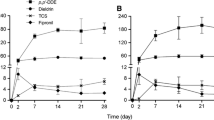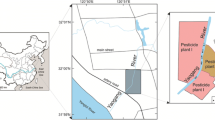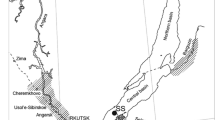Abstract
Little is known about the environmental behavior of fenhexamid (FEN) in aquatic ecosystems such as degradation and bioaccumulation, in spite of the fact that it is critical for a comprehensive assessment of its ecological risks. This study investigated for the first time the degradation of FEN in water-sediment systems under both aerobic and anaerobic conditions and also bioaccumulation by zebrafish (Danio rerio). Water and sediments from different natural waters including river HR and lake HL were applied to build up water-sediment microcosms in the laboratory. When FEN was introduced into the aqueous phase, it would partition from water to sediment gradually and be decomposed in sediment compartment. The dissipation half-lives of FEN in water were 43.8, 75.9, 31.3, and 37.2 days for HR-aerobic, HR-anaerobic, HL-aerobic, and HL-anaerobic microcosms, respectively. Moreover, FEN degradation rate constants of whole systems varied from 0.0045 to 0.0088 per day and the half-lives were from 78.4 to 155 days. The aerobic circumstances were demonstrated to be favor of FEN degradation. The bioconcentration factor (BCF) was 2.6–3.1 obtained from zebrafish exposure experiments at environmentally relevant concentrations. Clearly, our results indicated that FEN could be accumulated in the deeper layer of sediment owing to the anaerobic condition against FEN degradation, but FEN showed a low potential for bioaccumulation. These may aid in comprehensive understanding the fate and risk of FEN in aquatic environment.



Similar content being viewed by others
References
Abbate, C., Borzì, D., Caboni, P., Baglieri, A., & Gennari, M. (2007). Behavior of fenhexamid in soil and water. Journal of Environmental Science and Health. Part. B, 42, 843–849.
Brumhard, B., Bornatsch, W. (1996). Aerobic degradation and metabolism of KBR 2738 in soil. Interner Bericht, Bayer AG: Leverkusen.
Brumhard, B., Bornatsch, W. (1997). Degradation and metabolism of KBR 2738 in the system water/sediment. Interner Bericht, Bayer AG: Leverkusen.
Chang, B. V., Yuan, S. Y., & Ren, Y. L. (2012a). Aerobic degradation of tetrabromobisphenol-A by microbes in river sediment. Chemosphere, 87, 535–541.
Chang, B. V., Yuan, S. Y., & Ren, Y. L. (2012b). Anaerobic degradation of tetrabromobisphenol-A in river sediment. Ecological Engineering, 49, 73–76.
Čuš, F., Česnik, H. B., Bolta, Š. V., & Gregorčič, A. (2010). Pesticide residues in grapes and during vinification process. Food Control, 21, 1512–1518.
Debieu, D., Bach, J., Hugon, M., Malosse, C., & Leroux, P. (2001). The hydroxyanilide fenhexamid, a new sterol biosynthesis inhibitor fungicide efficient against the plant pathogenic fungus Botryotinia fuckelinan (Botrytis cinerea). Pest Management Science, 57, 1060–1067.
El-Amrani, S., Pena-Abaurrea, M., Sanz-Landaluze, J., Ramos, L., Guinea, J., & Camara, C. (2012). Bioconcentration of pesticides in zebrafish eleutheroembryos (Danio rerio). Science of the Total Environment, 425, 184–190.
Francesc, A. E.-T., Antonio, A.-F., & Josep, V. M. (2011). Determination of fenhexamid residues in grape must, kiwifruit, and strawberry samples by enzyme-linked immunosorbent assay. Food Chemistry, 124, 1727–1733.
Hem, L., Choi, J.-H., Park, J.-H., Mamun, M. I. R., Cho, S.-K., El-Aty, A. M. A., & Shim, J.-H. (2011). Residual pattern of fenhexamid on pepper fruits grown under greenhouse conditions using HPLC and confirmation via tandem mass spectrometry. Food Chemistry, 126, 1533–1538.
Huang, X. L., Wu, C. X., Xiong, X., Zhang, K., & Liu, J. T. (2014). Partitioning and degradation of triclosan and formation of methyl-triclosan in water-sediment systems. Water, Air, & Soil Pollution, 225, 2099.
Liu, M., Liu, D., Xu, Y., Jing, X., Zhou, Z., & Wang, P. (2015). Fate and stereoselective behavior of benalaxyl in a water-sediment microcosm. Journal of Agricultural and Food Chemistry, 63, 5205–5211.
Łozowicka, B., Jankowska, M., & Kaczyński, P. (2012). Pesticide residues in Brassica vegetables and exposure assessment of consumers. Food Control, 25, 561–575.
Medjakovic, S., Zoechling, A., Gerster, P., Ivanova, M. M., Teng, Y., Klinge, C. M., Schildberger, B., Gartner, M., & Jungbauer, A. (2014). Effect of nonpersistent pesticides on estrogen receptor, androgen receptor, and aryl hydrocarbon receptor. Environmental Toxicology, 29, 1201–1216.
Narushima, T., Sato, T., Goto, Y., & Takahashi, Y. (2014). Pesticides in river and tap water in a rice production area of Niigata, Japan. Water, Air, & Soil Pollution, 225, 2229.
Organization for Economic Cooperation and Development (OECD). (1998). Guide-lines for testing chemicals. No. 212. Paris.
Organization for Economic Cooperation and Development (OECD). (2002). Guide-lines for testing chemicals. No. 308. Paris.
Organization for Economic Cooperation and Development (OECD). (2012). Guide-lines for testing chemicals. No. 305. Paris.
Peng, Y. H., Chen, Y. J., Chang, Y. J., & Shinh, Y. H. (2015). Biodegradation of bisphenol A with diverse microorganisms from river sediment. Journal of Hazardous Materials, 286, 285–290.
Pinna, M. V., Budroni, M., Farris, G. A., & Pusino, A. (2008). Fenhexamid adsorption behavior on soil amended with wine lees. Journal of Agricultural and Food Chemistry, 56, 10824–10828.
PMRA-Pest Management Regulatory Agency of Health Canada. (2003). Fenhexamid proposed regulatory decision document. http://publications.gc.ca/collections/Collection/H113-9-2003-4E.pdf. Accessed on 19 Dec 2016.
Rosslenbroich, H.-J., & Stuebler, D. (2000). Botrytis cinerea-history of chemical control and novel fungicides for its management. Crop Protection, 19, 557–561.
Song, Z. H., & Zhang, Y. Y. (2016). Toxicity and bioaccumulation of omethoate in Danio rerio. Journal of Hydroecology, 37, 89–94 (in Chinese).
Vance, E. D., Brookes, P. C., & Jenkinson, D. S. (1987). An extraction method for measuring soil microbial biomass C. Soil Biology and Biochemistry, 19, 703–707.
Volpe, A., Pagano, M., Mascolo, G., Grenni, P., & Rossetti, S. (2017). Biodegradation of UV-filters in marine sediments. Science of the Total Environment, 575, 448–457.
Wang, Y., Xu, L., Li, D., Teng, M., Zhang, R., Zhou, Z., & Zhu, W. (2015). Enantioselective bioaccumulation of hexaconazole and its toxic effects in adult zebrafish (Danio rerio). Chemosphere, 138, 798–805.
Wang, S., Seiwert, B., Kästner, M., Miltner, A., Schäffer, A., Reemtsma, T., Yang, Q., & Nowak, K. M. (2016). (Bio)degradation of glyphosate in water-sediment microcosms-A stable isotope co-labeling approach. Water Research, 99, 91–100.
Zhang, Q., Zhou, L. L., Yang, Y., Hua, X. D., Shi, H. Y., & Wang, M. H. (2015). Study on the stereoselective degradation of three triazole fungicides in sediment. Ecotoxicology and Environmental Safety, 117, 1–6.
Zou, J. X., He, X. K., Tao, C. J., Piao, X. Y., & Jiang, H. (2006). Acute toxicity and bio-concentration of fluoroglycofen-ethyl to Brachydonio rerio. Chinese Journal of Pesticide Science, 8, 375–378 (in Chinese).
Acknowledgments
This work was supported by the National Natural Science Foundation of China [grant number 31401772], Zhejiang Province of Natural Science Foundation [grant numbers LQ16B070003, 2015C32039], the National Natural Science Foundation of China [grant numbers 31501685, 31501668] and Young Scientists Training Program of Zhejiang Academy of Agricultural Sciences. The authors are very grateful to anonymous reviewers for helpful comments and suggestions.
Author information
Authors and Affiliations
Corresponding authors
Electronic Supplementary Material
Below is the link to the electronic supplementary material.
Table S1
(DOCX 74 kb)
Rights and permissions
About this article
Cite this article
Xu, Z., Hu, X., Wu, M. et al. Fate of Fenhexamid in Water-Sediment Systems: Degradation Under Aerobic/Anaerobic Conditions and Bioaccumulation by Zebrafish (Danio rerio). Water Air Soil Pollut 228, 134 (2017). https://doi.org/10.1007/s11270-017-3319-3
Received:
Accepted:
Published:
DOI: https://doi.org/10.1007/s11270-017-3319-3




